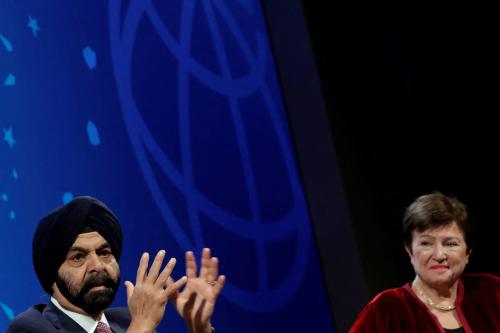The replenishment process for concessional resources of the multilateral development banks is broken. We have come to this conclusion after a review of the experience with recent replenishments of multilateral development funds. We also base it on first-hand observation, since one of us was responsible for the World Bank’s International Development Association (IDA) replenishment consultations 20 years ago and recently served as the external chair for the last two replenishment consultations of the International Fund for Agricultural Development (IFAD), which closely follow the common multilateral development bank (MDB) practice. As many of the banks and their donors are preparing for midterm reviews as a first step toward the next round of replenishment consultations, this is a good time to take stock and consider what needs to be done to fix the replenishment process.
So what’s the problem?
Most of all, the replenishment process does not serve its key intended function of setting overall operational strategy for the development funds and holding the institutions accountable for effectively implementing the strategy. Instead, the replenishment consultations have turned into a time-consuming and costly process in which donor representatives from their capitals get bogged down in the minutiae of institutional management that are better left to the boards of directors and the managements of the MDBs. There are other problems, including lack of adequate engagement of recipient countries in donors’ deliberations, the lack of full participation of the donors’ representatives on the boards of the institutions in the process, and inflexible governance structures that serve as a disincentive for non-traditional donors (from emerging countries and from private foundations) to contribute.
But let’s focus on the consultation process. What does it look like? Typically, donor representatives from capitals assemble every three years (or four, in the case of the Asian Development Bank) for a year-long consultation round, consisting of four two-day meetings (including the meeting devoted to the midterm review of the ongoing replenishment and to setting the agenda for the next consultation process). For these meetings, MDB staff prepare, per consultation round, some 20 substantive documents that are intended to delve into operational and institutional performance in great detail. Each consultation round produces a long list of specific commitments (around 40 commitments is not uncommon), which management is required to implement and monitor, and report on in the midterm review. In effect, however, this review covers only half the replenishment cycle, which leads to the reporting, monitoring, and accountability being limited to the delivery of committed outputs (e.g., a specific sector strategy) with little attention paid to implementation, let alone outcomes.
The process is eerily reminiscent of the much maligned “Christmas tree” approach of the World Bank’s structural adjustment loans in the 1980s and 1990s, with their detailed matrixes of conditionality; lack of strategic selectivity and country ownership; focus on inputs rather than outcomes; and lack of consideration of the borrowers’ capacity and costs of implementing the Bank-imposed measures. Ironically, the donors successfully pushed the MDBs to give up on such conditionality (without ownership of the recipient countries) in their loans, but they impose the same kind of conditionality (without full ownership of the recipient countries and institutions) on the MDBs themselves—replenishment after replenishment.
Aside from lack of selectivity, strategic focus, and ownership of the commitments, the consultation process is also burdensome and costly in terms of the MDBs’ senior management and staff time as well as time spent by ministerial staff in donor capitals, with literally thousands of management and staff hours spent on producing and reviewing documentation. And the recent innovation of having donor representatives meet between consultation rounds as working groups dealing with long-term strategic issues, while welcome in principle, has imposed further costs on the MDBs and capitals in terms of preparing documentation and meetings.
It doesn’t have to be that way. Twenty years ago the process was much simpler and less costly. Even today, recent MDB capital increases, which mobilized resources for the non-concessional windows of the MDBs, were achieved with much simpler processes, and the replenishment consultations for special purpose funds, such as the Global Fund for HIV/AIDS, tuberculosis, and malaria and for the GAVI Alliance, are more streamlined than those of the MDBs.
So what’s to be done?
We recommend the following measures to fix the replenishment consultation process:
- Focus on a few strategic issues and reduce the number of commitments with an explicit consideration of the costs and capacity requirements they imply. Shift the balance of monitoring and accountability from delivery of outputs to implementation and outcomes.
- Prepare no more than five documents for the consultation process: (i) a midterm review on the implementation of the previous replenishment and key issues for the future; (ii) a corporate strategy or strategy update; (iii) the substantive report on how the replenishment resources will contribute to achieve the strategy; (iv) a financial outlook and strategy document; and (v) the legal document of the replenishment resolution.
- Reduce the number of meetings for each replenishment round to no more than three and lengthen the replenishment period from three to four years or more.
- Use the newly established working group meetings between replenishment consultation rounds to focus on one or two long-term, strategic issues, including how to fix the replenishment process.
The initiative for such changes lies with the donor representatives in the capitals, and from our interviews with donor representatives we understand that many of them broadly share our concerns. So this is a good time—indeed it is high time!—for them to act.



Commentary
It’s time for the multilateral development banks to fix their concessional resource replenishment process
September 9, 2015